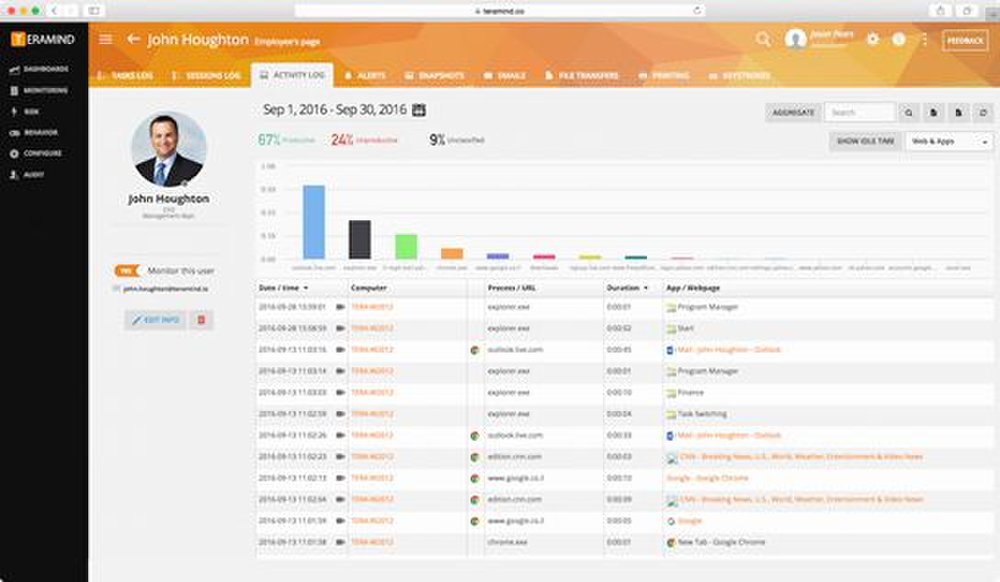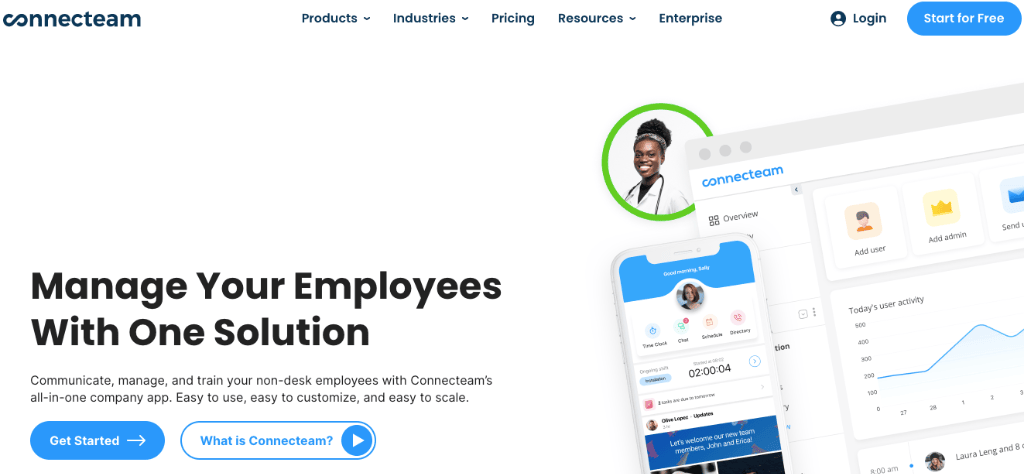It's a type of software that allows organizations to track, monitor and document the actions of employees. It allows employers to gather data on various aspects of the behavior of employees, such as internet usage and application usage, keystrokes as well as screenshots. The main purpose behind employee monitoring software is to increase productivity, make sure that employees are in the compliance of company policies, protect sensitive information and address security issues. When choosing an employee tracking software, there are many aspects to take into consideration. These are the main things to remember features: Decide on the features your organization needs based on its requirements. The most common features are blocking websites keys, keystroke logs, applications usage tracking and email monitoring. Make sure you only use features that are relevant to your monitoring needs.
Compliance and Privacy - Be sure that the software complies to ethical and legal standards regarding employee monitoring. Know the relevant laws and regulations in your local area. Software that safeguards privacy for employees must be transparent and customizable settings.
User-Friendliness: Consider the software's user-friendliness and accessibility. Simple installation and a simple interface can simplify the process and save you time. Look for customizable dashboards with intuitive reporting tools, as well as other options that allow you to quickly browse and analyze data.
Integration and Compatibility- Verify that the software is seamlessly integrated with your existing IT infrastructure and with the systems you use like operating systems, email clients, tools for managing projects, and collaboration platforms. Compatible software ensures continuous monitoring, and doesn't interrupt your daily work.
Data Security: Evaluate the software’s security measures for protecting the information collected. Access controls, encryption, secure storage of data, and compliance to industry standard security protocols are vital. Check the security practices of the software.
Scalability- You should consider the software's scalability to accommodate the growth of your organization. If you expect to grow your team or open new locations in the future select a software program that can easily be expanded to meet the changing demands.
Analytics and Reporting The software's analytics and reporting capabilities. Find features that offer complete information on the productivity of employees, their timing allocation, and trends. Customized analytics and reports can assist you in making informed choices and make improvements.
Customer Support - Examine the quality and availability of customer support offered by software providers. Check the availability of their technical support and also. If problems arise, a excellent customer service guarantees that you are provided with quick assistance.
Cost- Consider the pricing model of the program, whether it is a one-time payment or subscription-based. Understand the pricing, and if there are additional charges for upgrades, support, or other features. Be sure to weigh the price of your product in relation to its worth and features.
Transparency and Communication between employees Transparency and Communication between employees - Establish transparent communication with your staff about the use and implementation of monitoring software. It is important to clearly define the goals and scope, as well as expectations and the limitations of monitoring. Inform them of how they can be protected and how they can address their concerns.
You can make an informed choice by considering these aspects and deciding on an employee monitoring program that will meet your needs while also respecting the privacy of your employees and meeting legal regulations. See the top time tracking monitoring software for more tips.
.png)
What Features Are Included In Employee Monitoring Software, And How Do They Differ?
Software designed to monitor employee activity has many features that can be utilized to analyze and track the behavior of employees. Certain features are standard to every employee monitoring software. It provides a comprehensive review of how employees use their time at work.
Keystroke Logging Keystroke Logging Keystroke recording records each keystroke employees type. It can be used to assist in finding productivity bottlenecks, deterring unauthorised activities, and gathering evidence in the event of an investigation.
Screenshots & Screen Recordings- Certain programs can take screen captures or record screens of employees at regular intervals. This can be useful to monitor productivity levels or troubleshooting.
Internet Usage Tracking This function records employees' internet activities, like searched for websites, visited sites, downloads, etc. It will help to identify inappropriate browsing or security risks.
Application Usage tracking- This feature tracks applications used during work hours by employees. It can help identify inappropriate or excessive usage of applications by providing insights into the applications frequented.
Email Monitoring lets employers keep track of all employee email. This includes sent and received emails, attachments to emails, as well the emails' content. It helps employers verify compliance with their policies as well as to stop data leaks and look into suspicious activity.
The tracking of documents and files This feature lets you track file modifications transfer, access, and modifications. It helps safeguard sensitive data by monitoring collaboration between documents and making sure that the data is protected according to protection policies.
Remote Monitoring- Remote monitoring capabilities let employers supervise employees working remotely or in various locations. Employers are able to monitor their activity and ensure that they work efficiently regardless of where they are.
Productivity AnalysisMonitoring software for employees typically includes features for productivity analysis that offer insight into work patterns of employees along with time allocation and overall levels of productivity. These analyses assist in identifying areas of improvement and help optimize workflow.
Reporting & Analytics- Robust tools for reporting and analytics create detailed reports using the data that is collected. These reports offer valuable insight into the performance of employees, resource allocation, and time management.
Software that provides features to ensure compliance and management of policies will ensure that the company's guidelines and policies are followed. They allow employers to establish guidelines for acceptable computer usage and internet access.
Alerts/Notifications: Alerts/notifications notify employers or managers when certain events or activities occur. They could alert them to excessive internet use and attempts to gain access to restricted websites or suspicious behaviour.
The functionality and availability of the features can vary between different products for employee surveillance. Be aware of the features offered by software that is compatible with your goals for monitoring and adhere to legal and ethical guidelines within your region. Have a look at the recommended employee monitoring services for blog examples.

How Does Employee Monitoring Software Comply With Compliance And Privacy Law?
Employee monitoring software must be in compliance with privacy and compliance laws. Here are a few ways employee monitoring software complies to privacy and compliance regulations, even though the legal requirements differ between different jurisdictions. Consent and notification- Certain jurisdictions require an informed consent from employees and require them to be informed of any surveillance activities prior to. The programs that monitor employees often have features that enable employers to effectively communicate monitoring guidelines to employees. It is possible to issue written notices, or request consent using consent forms. Additionally an employee manual that provides guidelines for monitoring may also be implemented.
Transparent Monitoring Policy - Employee monitoring software promotes transparency by ensuring that employees are aware of the kinds of information gathered as well as their intended use and the extent to which monitoring is performed. Clear and comprehensive policies allow employees to be aware of the limitations and rights of privacy and monitoring.
Data Minimization: To make sure that employee monitoring programs comply with privacy regulations They usually follow the principle of data minimization. This means that only relevant information is collected and kept as unnecessary or irrelevant data is discarded. By restricting data collection to what is required for monitoring purposes The software minimizes privacy risks and encourages compliance.
Anonymization or Aggregation - Some software designed to monitor employee behavior can anonymize and aggregate information to protect the privacy of employees. The data collected is filtered to hide personally identifiable information. Data from multiple employees is combined to give insights on a group-level without identifying any individual.
Secure data storage and encryption Software for monitoring employees places the most importance on data security. It employs secure data storage techniques and encryption to safeguard data against unauthorised access, breaches, or even accidentally released data. This also includes safeguarding data in transit and when in the rest of its life.
Access Controls and Restricted Permissions To ensure compliance, employee monitoring software often offers granular access control and permissions. Employers can limit the number of authorized users that are able to access the monitoring data such as HR personnel or designated administrator.
Rights and Remedies for Employees Rights and remedies: The protection of the rights of employees is vital for ensuring that they are in compliance with the privacy and compliance laws. Most employee monitoring programs contain tools that allow employees to look over their personal data and make corrections, or even submit complaints. This permits employees to decide to take action and exercise their rights if they feel that privacy rights have been violated.
Conformity to Data Protection Regulations – Software for monitoring employees is designed to comply with the applicable regulations. For instance, the General Data Protection Regulations of the European Union and the California Consumer Privacy Acts of the United States. This includes implementing measures to ensure the security of personal information and protect the rights of data subjects.
Apart from employing employee monitoring tools, organizations should consult experts in the field of law and remain up to date regarding the latest laws and regulations in their jurisdiction. Compliance and privacy laws require a comprehensive plan that goes beyond more than just software. It also calls for clear policies, regular monitoring of compliance, and ongoing education. Follow the recommended time tracking monitoring software for blog recommendations.
